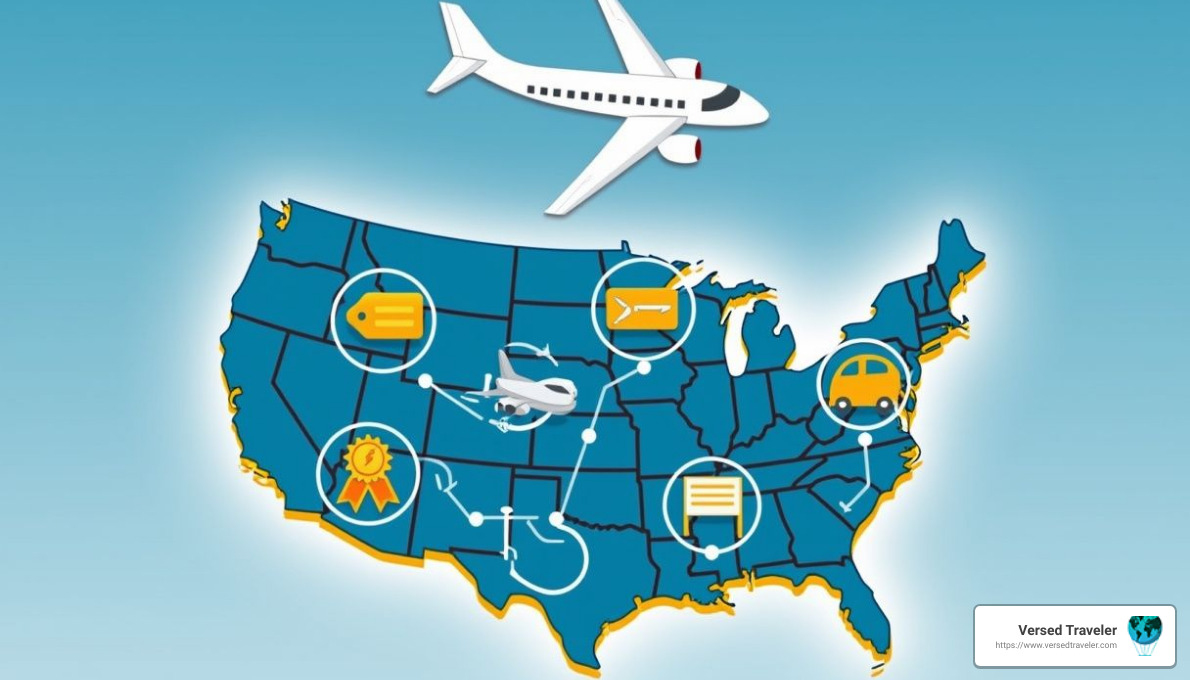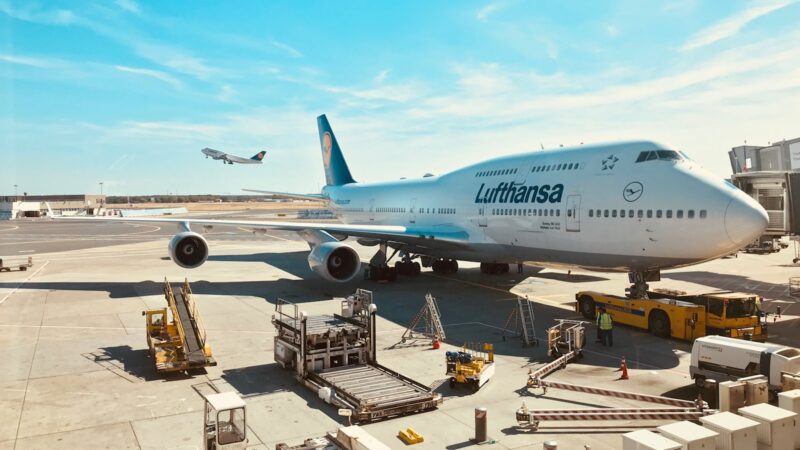Frequent flyer comparison is a hot topic among travelers aiming to make the most of their journeys. With numerous airlines offering their own frequent flyer programs, it’s crucial to understand how these loyalty schemes can optimize your travel rewards. Here’s a quick snapshot of what you need to know:
- Frequent Flyer Programs: Airlines like Delta, American, and United offer programs that let you earn miles for flights.
- Loyalty Matters: Focus on one main program to reap maximum rewards and perks.
- Travel Rewards: Use your accumulated miles for free flights, upgrades, or special discounts.
Navigating the myriad options can be daunting, but don’t worry—Versed Traveler is here to guide you through these complexities.
I’m Gabrielle Reese VT, a frequent traveler and expert on airline loyalty programs. My background is rich in exploring travel rewards and frequent flyer comparison, helping explorers like you make informed choices. In the next sections, we’ll dig deeper into how you can benefit from these programs.
Learn more about frequent flyer comparison:
– Airlines with no change fees
– air fare compare
– compare air travel
Table of Contents
ToggleWhat is a Frequent Flyer Program?
Frequent flyer programs are loyalty schemes offered by airlines to reward their loyal customers. These programs let you earn miles or points every time you fly with an airline or use services from their partners, like hotels or car rentals. You can then redeem these miles for flights, upgrades, and other perks.
How It Works
When you join a frequent flyer program, you start accumulating miles or points. Think of these as currency for travel rewards. The more you fly or use partner services, the more points you earn. Over time, you can use these points to book free flights, get seat upgrades, or even enjoy lounge access.
But it’s not just about collecting miles. Frequent flyer programs also offer elite status. This is like leveling up in a game. The more you fly, the higher your status. And with higher status comes better perks—like priority boarding, extra baggage allowance, and more.
Earning Miles
Earning miles isn’t just limited to flying. Many airlines have partnerships with credit card companies, hotels, and even shopping portals. For example, by using an airline’s co-branded credit card, you can earn miles on everyday purchases like groceries or gas.
Redeeming Miles
Once you’ve accumulated enough miles, you can redeem them for a variety of rewards. This could be a free flight to your dream destination, an upgrade to business class, or even a hotel stay. However, the number of miles needed can vary. Some airlines use a fixed award chart, while others have dynamic pricing, meaning the miles needed can change based on demand.
Elite Status
Achieving elite status can significantly improve your travel experience. There are usually several tiers, each offering more benefits than the last. For instance, with Delta SkyMiles, reaching Medallion status can get you perks like complimentary upgrades and access to exclusive lounges.
Key Takeaways
- Loyalty Programs: Join for free and start earning miles or points.
- Miles and Points: Use them like currency for flights, upgrades, and more.
- Elite Status: Fly more to open up better perks and benefits.
Frequent flyer programs are a great way to make your travel more rewarding. By understanding how they work, you can maximize your benefits and enjoy a smoother journey. Next, we’ll explore how to choose the best frequent flyer program for your needs.
How to Choose the Best Frequent Flyer Program
Selecting the right frequent flyer program can make your travel experiences more rewarding and cost-effective. Here’s how to narrow down your options based on hub city, travel habits, goals, network coverage, and flight options.
Hub City
Where you live plays a big role in choosing a frequent flyer program. Airlines have hub cities where they operate most of their flights. If you reside in or near a hub city, you are likely to find more direct flights, making travel more convenient. For example, if you’re based in Atlanta, Delta SkyMiles might be a practical choice due to Delta’s extensive presence there.
Travel Habits
Consider your travel frequency and destinations. If you often travel domestically, a program like Southwest Rapid Rewards could be appealing with its simple rewards structure and no blackout dates. On the other hand, if international travel is your thing, American Airlines AAdvantage or United MileagePlus, which are part of global alliances, might offer better international flight options.
Goals
What do you want out of the program? If you’re aiming for premium experiences, look for programs that offer upgrades and lounge access. United MileagePlus, for instance, provides long-haul upgrades and elite perks, which are great for frequent international travelers. If your goal is to earn free flights quickly, focus on programs with easy mile-earning options through credit cards and partner networks.
Network Coverage
The airline’s network is crucial. Check how many destinations the airline and its partners cover. Programs like United MileagePlus, part of the Star Alliance, offer extensive global coverage, making it easier to redeem miles for international flights. Evaluate the airline’s network in relation to your most frequented or desired destinations.
Flight Options
Consider the types of flights and cabins available. If you prefer flying in economy, Southwest’s straightforward approach might suit you. However, if you desire premium cabins, explore options like Delta SkyMiles, which allows earning through credit card spending and offers Medallion elite status for additional benefits.
By evaluating these criteria, you can align your frequent flyer program choice with your personal travel needs and preferences. This strategic approach ensures you maximize the benefits and rewards of your chosen program.
Next, we’ll dive into the top frequent flyer programs for 2024-2025, examining what each has to offer.
Top Frequent Flyer Programs for 2024-2025
When it comes to frequent flyer programs, there’s no one-size-fits-all. Each airline offers unique perks and benefits. Let’s explore the top programs for 2024-2025 and see what they bring to the table.
Alaska Airlines Mileage Plan
Alaska Airlines Mileage Plan stands out for domestic travelers and is part of the Oneworld Alliance, which opens up a world of possibilities with partner airlines. One of its best features is the award chart, which makes it easy to know how many miles you’ll need for a trip. Plus, Alaska offers a stopover allowance on one-way awards, letting you explore an extra city without spending more miles.
American Airlines AAdvantage
American Airlines AAdvantage is another strong contender, especially for those who value elite status. As part of the Oneworld Alliance, it allows you to earn and redeem miles across a vast network of partner carriers. AAdvantage is one of the few programs that still publishes an award chart, helping you plan your redemptions with confidence. The program also offers perks like upgrades and lounge access for its elite members.
United MileagePlus
United’s MileagePlus program is ideal for those seeking long-haul upgrades and elite perks. As a member of the Star Alliance, United provides extensive global coverage. While the program uses dynamic pricing, making award costs vary, it compensates with valuable perks for frequent travelers. Members can enjoy upgrades and additional benefits, enhancing their flying experience.
Delta SkyMiles
Delta SkyMiles is known for its dynamic pricing model, which can be a double-edged sword. However, the program shines with its Medallion elite status, which offers a range of benefits, including upgrades and priority boarding. Delta also allows members to earn miles through credit card spending, making it easier to accumulate rewards without flying frequently.
Southwest Rapid Rewards
For those focused on domestic travel, Southwest Rapid Rewards is a straightforward option. The program’s Companion Pass is a highlight, allowing a designated person to fly with you for free (excluding taxes and fees) once you earn enough points. With no blackout dates and a simple rewards structure, Southwest makes it easy to book flights and enjoy travel rewards.
Each of these programs offers distinct advantages depending on your travel needs. Whether you’re looking for international partnerships, easy-to-understand redemption options, or domestic perks, there’s a frequent flyer program that can improve your travel experience. We’ll explore the key criteria for comparing these programs to help you make the best choice.
Frequent Flyer Comparison: Key Criteria
Choosing the right frequent flyer program can feel overwhelming, but breaking it down into key criteria can simplify the process. Let’s look at the essential factors to consider: earning miles, redemption rates, elite status requirements, and partner airlines.
Earning Miles
Earning miles is the foundation of any frequent flyer program. Most programs have shifted from distance-based to revenue-based models. This means you earn miles based on the price of your ticket rather than how far you fly.
- Alaska Airlines Mileage Plan and Southwest Rapid Rewards still offer traditional distance-based earning, which can be advantageous for long-haul flights.
- Delta SkyMiles and United MileagePlus focus on ticket cost, rewarding high spenders more generously. Delta even allows earning miles through credit card spending, offering flexibility for non-flyers.
Redemption Rates
Once you’ve earned miles, the next step is redeeming them for flights, upgrades, or other perks. This is where redemption rates come into play.
- American Airlines AAdvantage and Alaska Airlines Mileage Plan are praised for maintaining award charts, providing clear mile requirements for flights.
- Programs like United MileagePlus and Delta SkyMiles use dynamic pricing. This means mile requirements can fluctuate based on demand, making it crucial to plan ahead for peak travel times.
Elite Status Requirements
Achieving elite status can open up valuable benefits such as upgrades, extra baggage allowance, and lounge access.
- American Airlines AAdvantage and Delta SkyMiles offer tiered elite status levels, with perks increasing as you climb the ranks.
- Southwest Rapid Rewards stands out with its Companion Pass, a unique perk allowing a designated person to fly with you for free once you reach certain spending thresholds.
Partner Airlines
Partner airlines expand your travel options and help you earn and redeem miles across a broader network.
- Alaska Airlines Mileage Plan is part of the Oneworld Alliance, providing extensive international coverage.
- United MileagePlus benefits from the Star Alliance, offering seamless connections and benefits with global carriers.
- Delta SkyMiles partners with SkyTeam, enhancing its international reach and offering more choices for travelers.
When comparing frequent flyer programs, consider how these criteria align with your travel habits and goals. Whether you’re a domestic traveler looking for straightforward rewards or an international jet-setter seeking global partnerships, understanding these key factors will guide you to the best program for your needs.
Next, we’ll address some frequently asked questions about frequent flyer programs to help you steer this landscape with ease.
Frequently Asked Questions about Frequent Flyer Programs
Is there a frequent flyer program for all airlines?
Yes, most major airlines offer frequent flyer programs to reward loyal customers. In the U.S., airlines like American Airlines, Delta Air Lines, United Airlines, and Southwest Airlines all have programs where you can earn miles or points. These programs often include partnerships with other airlines, hotels, and even car rental agencies, allowing you to accumulate points not just from flying but from various travel-related activities.
How to pick an airline loyalty program?
Selecting the right airline loyalty program depends on several factors:
-
Flight Options and Network Coverage: Consider your home airport and the airlines that operate hubs there. If you live near a major hub for a specific airline, it might offer the most convenient flight options. For example, Delta Air Lines has a strong presence in Atlanta, while United Airlines dominates in Chicago.
-
Earning Free Flights: Look at how each program allows you to earn miles. Some programs, like Alaska Airlines Mileage Plan, still use distance-based earning, which can be beneficial for longer flights. Others, like Delta SkyMiles, focus on revenue-based earning, rewarding you based on ticket price.
-
Partner Airlines: Check if the airline is part of an alliance like Oneworld, Star Alliance, or SkyTeam. This expands your travel options and provides more opportunities to earn and redeem miles.
How many flyer miles do you need for a free flight?
The number of miles needed for a free flight can vary widely based on several factors:
-
Class of Service: Flights in business or first class require more miles than economy class. For instance, a business class ticket might cost twice as many miles as an economy ticket.
-
Region-Based Pricing: Some airlines use fixed award charts, where the miles required depend on the regions you’re traveling between. American Airlines AAdvantage is known for maintaining a clear award chart system.
-
Dynamic Pricing: Programs like Delta SkyMiles use dynamic pricing, meaning the miles required fluctuate based on demand, route, and time of booking. This can make it tricky to predict how many miles you’ll need, especially during peak travel times.
Understanding these aspects can help you better steer frequent flyer programs and make the most of your miles. With this knowledge, you can tailor your loyalty program choice to fit your travel habits and preferences, ensuring you get the most value from your flights.
Conclusion
Navigating frequent flyer programs can seem daunting, but with the right tools and knowledge, it becomes an opportunity to improve your travel experiences. At Versed Traveler, we’re committed to providing you with the most comprehensive travel information, including detailed airline comparisons and essential travel tips.
Whether you’re a frequent flyer or just starting your travel journey, understanding the nuances of these programs can make a significant difference. From selecting the best program based on your hub city and travel habits to maximizing your miles through strategic partnerships, there’s a wealth of benefits waiting to be open uped.
Our goal is to be your one-stop source for all things travel. We cover everything from choosing the right frequent flyer program to exploring destinations and understanding travel essentials. With our guidance, you can make informed decisions that lead to more rewarding and cost-effective travel experiences.
For more insights and tips on how to make the most of your travel trips, visit our Travel Tips and Recommendations page. Here, you’ll find a treasure trove of information designed to help you steer the skies with confidence and ease.
The world of travel is vast, but with the right information, you can explore it with ease and excitement. Let us be your guide as you start on your next trip.












